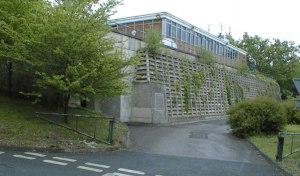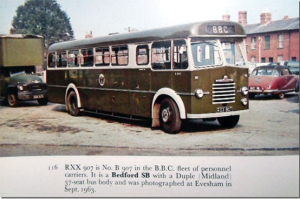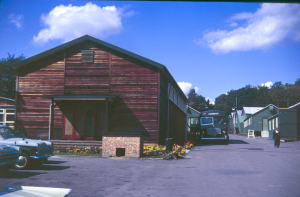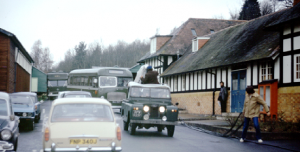GWR Hall Class Names
Alec Bray
Anyone who went to Wood Norton up to the mid-sixties and who travelled to Evesham by rail would have come across former Great Western locomotives.
The Great Western – and British Rail Western Region – built a particular class of locomotives called the “Hall” Class – a total of 259 were built. Finding suitable names for this number of locomotives was quite a task.
The received wisdom is that as the GWR constructed more and more “Halls”, the GWR began to run out of names of Halls in the GWR region or territory, and began to look further afield – examples are Graythwaite Hall (6976) in the Lake District, and Fountains Hall (7904) and the preserved locomotive Burton Agnes Hall (6998) in Yorkshire.
The GWR overlooked one Hall in the midst of their territory: Wood Norton Hall.
Now, for many years Wood Norton Hall was the site of the BBC’s engineering training college: it was also planned as a regional broadcasting centre in the case of calamitous enemy action in a war – and also planned as a regional centre of government – complete with bunker. The Hall itself is a Grade II listed Victorian stately home. It was the last home in England of Prince Philippe, Duke of Orléans, who claimed the throne of France.
So why did the GWR not name a (modified?) Hall “Wood Norton Hall”? Original Hall 4965 was named “Rood Ashton Hall” (differs by only 4 letters!) so there was no problem as to the length of the name etc (and of course Rood Ashton Hall has an “interesting” history all of its own!).
No one from the Great Western Society has offered an explanation …
I wonder if, because of the possible strategic importance of Wood Norton Hall, the GWR did not publicise it (for one reason or another).
PAWN and the Bunker
Ian Hilson
http://www.nettleden.com/venues/pawn/
PAWN (Protected Area Wood Norton) … a transmission tower is the only clue to motorists of its existence…
Mark Jordan
I am not sure quite how accurate is that web-page. The mast was mainly for the DF links from Daventry and I don’t think the bunker was ever equipped. (I stand corrected). We were not allowed entry but there MAY have been a buried site as per the photo.
Certainly most of the programme routing was in a little annexe of the Control Room (where we re-routed Radio Caroline to ring main instead of the Light Programme from Droitwich on a landline).
Hut 1 at the top of the hill (a wooden one in the old days) was the base for the links but I suspect has been re-built now.
R4 was moved there during the BH Extension power tests.
Albert Barber
from: http://www.subbrit.org.uk/rsg/sites/w/woodnorton/
(Subterranea Britannica)
“… In the late 1960s or early 1970s, a new block of lecture theatres and training laboratories was built – on top of this substantial nuclear bunker, which was finished in 1967. The building is known as Bredon Wing.
… The photo shows the back of the building. At the front, the top of the bunker is at ground level…”
Malcolm Walker via Albert Barber
When I was at Wimbledon it seemed to me to be a good idea to have on show in the broadcast centre some artefacts of broadcasting. So I approached the BBC quite formally and they denied having anything by way of old equipment. However I knew that in the bunker at Wood Norton there were several useful items. So I approached the then head of the place who claimed he knew nothing. So I went there and took him in to the bunker where happily I found old cameras, very old recording machines (sound of course) microphones and all sorts of things. To this day they are on display in the broadcast centre at Wimbledon, decently displayed together with many photos of early days.
Graeme Wall
In connection with the GWR locomotive names, I suspect the simple answer is no one in the Swindon office that allocated names had heard of it! It is not one of the grander stately homes.
On another subject …
I remember a pint in my local pub going over 2/- in late 1968 and it was still less that half a crown in the Evesham club bar in 1969.
Mike Jordan
From memory, while on TA22 (1966, would you believe) lunchtime at ‘The Anchor’ in Fladbury was about 9d for the pint of local cider as opposed to the stuff with green bits floating in it at Emley Castle that was cheaper at 6d a pint! Made the afternoon lectures pass more quickly though. Fladbury did do lunches with the makings provided by local farmers who swapped produce for the pint!I also seem to remember that the fuel for my yellow Morris Minor was about 1/6 a gallon as well. It was my first car after passing my test in Evesham in a Hillman Imp. Always a good place to take a test with only the lights (pedestrian?) near the club (by the cinema) and a few in the middle and at Workman Bridge. The only roundabout rarely got used on the test as it was on the road to Broadway so “…no turning back…”.
The Mayflower Bus
Bernie Newnham
I have been listening to a Radio 4 programme from long ago, about the beginnings of Wood Norton: http://www.tech-ops.co.uk/listening_to_war.mp3
During the programme, Alvar Liddell mentioned the Mayflower bus. I’m sure that we got on the Mayflower bus to Wood Norton much later in 1966 (and 1967, 1968 and 1969).
Chris Booth
Was it waiting for members of TA17?
Hugh Sheppard, Dave Plowman
The red car in the background is an Austin A90 Atlantic; one of Austin’s failed attempts to make a car in Britain that would appeal to the US market. It is believed that the A90 Atlantic ceased production at about the time of the merger of Austin into BMC.
Mike Jordan
The Mayflower bus was replaced by a more modern one by 1968!
Michael Cotton
This picture of 2 buses was taken on STO Course 41 extravaganza. The person cable bashing is Jon Vincent, we had every camera cable plugged in series to get moving pictures from our Roving Eye, a Land Rover, with Martin Mathewson, a Roving Eye OB Cameraman, operating it.







